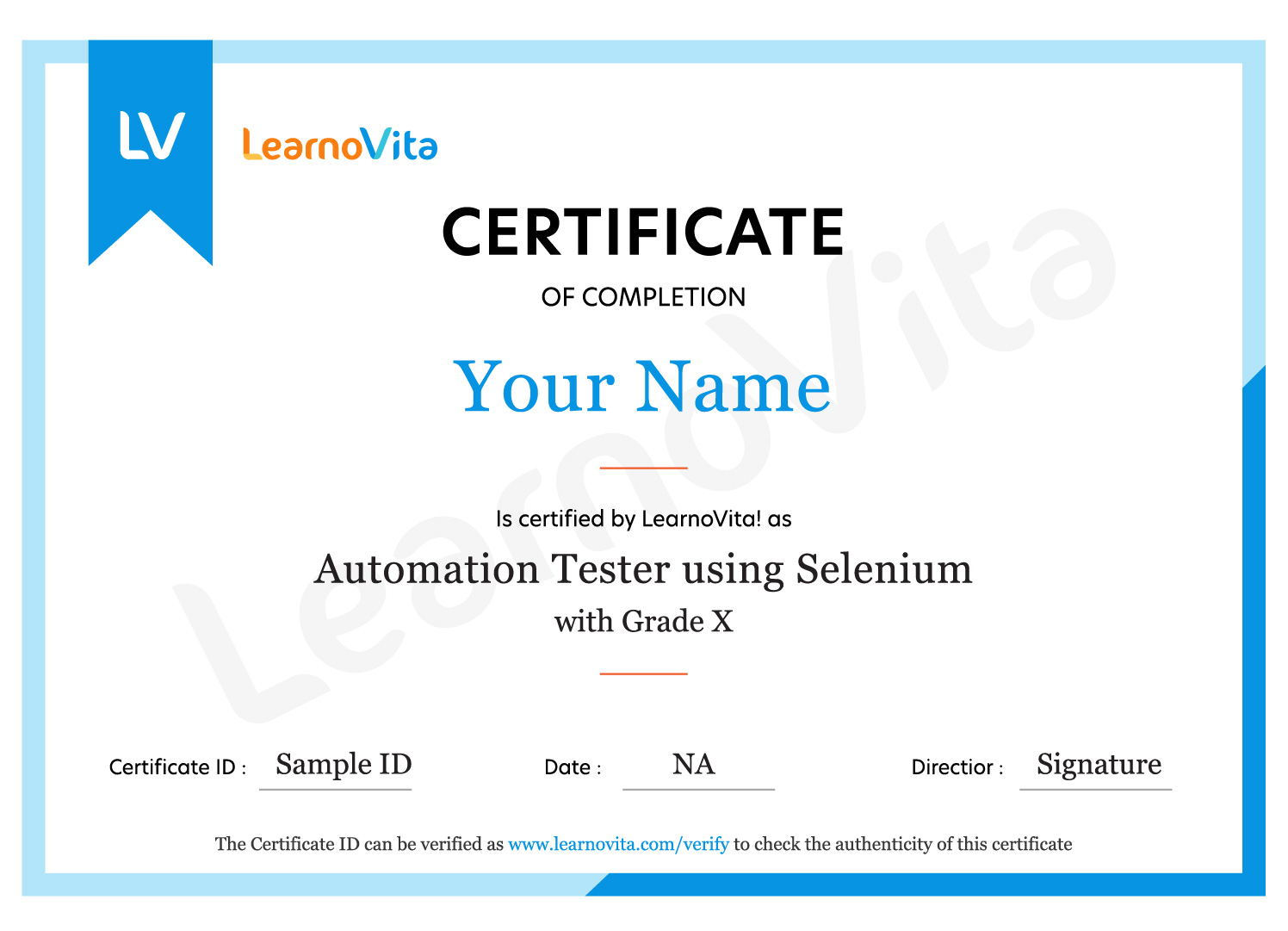A Comprehensive of Splunk Course Overview
Learnovita’s Splunk training in Pune offers a comprehensive exploration of the essential skills, tools, and techniques required to master Splunk effectively. The course begins with a thorough introduction to Splunk’s architecture, key functionalities, and advantages. Our Splunk course in Pune is designed to provide in-depth knowledge of searching, reporting, and monitoring using Splunk. Participants will learn to efficiently collect, analyze, and visualize data, enhancing their ability to leverage Splunk for various analytical and operational needs. This training equips students with the expertise needed to excel in data-driven roles and significantly boosts their professional credibility and career advancement prospects.With the Splunk certification course in Pune, you’ll gain hands-on skills to work on real-world scenarios. Enroll now to build a strong foundation in data analysis, operational intelligence, and Splunk administration.
Additional Info
Innovative Trends in Splunk Management
- Expansion of Cloud Capabilities:
The future of Splunk will see a greater emphasis on cloud-based solutions, with enhancements in scalability and flexibility. Splunk Cloud will evolve to support more seamless integrations with other cloud services and platforms. Advancements will focus on optimizing cloud data management and improving cost efficiency for cloud deployments. Increased use of hybrid cloud environments will enable better data synchronization and accessibility. These improvements will cater to the growing demand for scalable, cloud-native data solutions.
- Enhanced Data Visualization Tools:
Advances in data visualization within Splunk will lead to more interactive and user-friendly dashboards. Future developments will include improved graphical representations of complex data sets and more customizable visual analytics. Enhanced visualization tools will support dynamic reporting and real-time data interaction. This will enable users to communicate insights and trends to stakeholders more effectively. Improved visual tools will also aid in quicker decision-making and more intuitive data exploration.
- Integration with the Internet of Things (IoT):
The integration of Splunk with IoT devices will enable comprehensive monitoring and analysis of connected systems. Future advancements will include enhanced capabilities for processing and analyzing large volumes of IoT data. Splunk will evolve to support real-time insights from diverse IoT sensors and devices. Improved data ingestion and correlation will allow for better anomaly detection and predictive maintenance. This integration will expand Splunk’s utility in industries reliant on IoT technologies.
- Improved Security Analytics:
As cybersecurity threats become more sophisticated, Splunk’s security analytics will advance to include more robust threat detection and response features. Real-time monitoring and automated response capabilities will be improved to address emerging security challenges. Enhanced security analytics will provide more comprehensive insights into potential vulnerabilities and attack patterns, strengthening Splunk’s role in cybersecurity.
- Advanced Automation Capabilities:
Future Splunk versions will incorporate advanced automation to streamline data management and operational tasks. Automation features will focus on reducing manual intervention and improving efficiency in data processing. Enhanced automation will support automated data ingestion, alerting, and report generation. This will allow users to focus on strategic decision-making while routine tasks are managed seamlessly. Automation advancements will make Splunk more efficient and user-friendly.
- Enhanced Data Integration and Interoperability:
Future developments will improve interoperability with various enterprise applications, databases, and data lakes. Enhanced data integration capabilities will support more comprehensive analytics and reporting. Splunk will focus on seamless data synchronization across different platforms and environments. These advancements will enable more holistic data analysis and insights.
- Scalability and Performance Optimization:
Future Splunk enhancements will focus on optimizing performance and scalability to handle increasing data volumes and user demands. Improvements will include more efficient data indexing, search capabilities, and storage management. Splunk will evolve to support larger-scale deployments with minimal latency. Advanced performance tuning will ensure that Splunk remains effective in high-demand environments. These optimizations will cater to growing organizational needs and data complexities.
- Enhanced User Experience and Interface Design:
Future Splunk versions will prioritize improvements in user experience and interface design to make the platform more intuitive. Advances will include more user-friendly navigation, customizable dashboards, and streamlined workflows. Enhanced interface design will focus on reducing complexity and improving accessibility for diverse user roles. User feedback will drive innovations aimed at simplifying interactions with the platform. These improvements will enhance overall usability and user satisfaction.
- Expansion of Analytics Capabilities:
Splunk’s future will include expanded analytics capabilities, with advancements in big data processing and advanced analytics. The platform will incorporate more sophisticated analytical tools and algorithms for in-depth data exploration. Enhancements will include support for advanced statistical analysis, machine learning, and predictive modeling. Expanded analytics capabilities will position Splunk as a leader in data-driven decision-making.
Top Splunk Job Openings in Leading Companies
- IBM:
IBM integrates Splunk into its suite of enterprise solutions, leveraging its data analysis capabilities for various business applications. Splunk professionals at IBM may work on optimizing data pipelines, enhancing security analytics, and developing custom solutions. IBM values expertise in data management and analytics, making it a prime employer for Splunk experts. The company’s diverse client base offers opportunities to work on innovative projects across multiple industries. Career roles at IBM include data analysts, security engineers, and IT consultants.
- Cisco:
Cisco utilizes Splunk to enhance its network security and performance monitoring solutions. Opportunities include roles in security operations, network analytics, and data engineering. Cisco’s global presence provides a dynamic environment for career growth in data analysis and network management. Employees contribute to improving Cisco’s cybersecurity posture and network efficiency.
- Amazon Web Services (AWS):
AWS incorporates Splunk into its cloud services to monitor and analyze cloud infrastructure. Splunk professionals at AWS focus on developing and managing cloud-based data solutions and integrations. Roles include cloud data engineers, security analysts, and solution architects. AWS offers a fast-paced environment with opportunities to work on cutting-edge cloud technologies. Splunk experts play a crucial role in enhancing AWS’s cloud observability and data management capabilities.
- Microsoft:
Microsoft uses Splunk to complement its suite of cloud and enterprise solutions, enhancing data analytics and security. Splunk professionals at Microsoft work on integrating and optimizing Splunk within Microsoft’s product offerings. Opportunities exist in areas such as cloud data management, security operations, and business intelligence. Microsoft’s global reach provides a platform for career advancement in data analytics and technology development. Employees contribute to innovative projects and solutions across various sectors.
- Google:
Google integrates Splunk to manage and analyze data across its vast infrastructure and services. Splunk professionals at Google work on developing data pipelines, enhancing data visibility, and improving security analytics. Roles include data engineers, security analysts, and cloud architects. Google’s emphasis on data-driven innovation offers a dynamic environment for career development. Splunk experts contribute to optimizing Google’s data management and analysis processes.
- Oracle:
Oracle employs Splunk to enhance its enterprise data management and security solutions. Splunk professionals at Oracle focus on integrating Splunk with Oracle’s cloud and on-premises systems. Opportunities include roles in data integration, security operations, and system administration. Oracle’s broad range of technology solutions provides a diverse environment for career growth. Employees work on projects that advance Oracle’s data analytics and security capabilities.
- SAP:
SAP integrates Splunk to support its enterprise resource planning (ERP) and data analytics solutions. Splunk professionals at SAP optimize data workflows, enhance security monitoring, and develop custom analytics solutions. Roles include data scientists, security engineers, and business analysts. SAP’s global presence offers a wide range of career opportunities in data management and analytics. Employees contribute to advancing SAP’s technology and solution offerings.
- ServiceNow:
ServiceNow utilizes Splunk to improve its IT service management and operations solutions. Splunk professionals at ServiceNow focus on enhancing data visibility, optimizing IT workflows, and managing security information. Opportunities include roles in data analysis, security operations, and IT infrastructure management. ServiceNow’s emphasis on digital workflows provides a dynamic environment for career advancement. Employees work on innovative projects that enhance ServiceNow’s platform capabilities.
- Dell Technologies:
Dell Technologies uses Splunk to manage and analyze data across its technology solutions. Splunk professionals at Dell focus on integrating Splunk with Dell’s data infrastructure and optimizing data analytics. Roles include data engineers, security analysts, and IT consultants. Dell’s broad range of technology solutions offers diverse career opportunities. Employees contribute to advancing Dell’s data management and analytics capabilities.
- Hewlett Packard Enterprise (HPE):
HPE employs Splunk to enhance its enterprise IT solutions and data analytics capabilities. Splunk professionals at HPE optimize data ingestion, enhance security monitoring, and develop custom solutions. Opportunities include roles in data analysis, security operations, and IT management. HPE’s focus on innovation provides a dynamic environment for career growth. Employees contribute to advancing HPE’s technology and data management solutions.
Key Prerequisites for Mastering Splunk
- Basic IT Knowledge:
A foundational understanding of IT concepts, including networking, operating systems, and system administration, is crucial. Familiarity with how data is generated and managed within IT environments will be beneficial. This knowledge provides context for Splunk’s data collection and analysis capabilities and helps in understanding the broader IT landscape. Basic IT skills lay the groundwork for more advanced Splunk functionalities.
- Understanding of Data Formats:
Knowledge of various data formats such as JSON, XML, and CSV is essential. Splunk processes diverse data types, so understanding these formats aids in adequate data ingestion. Familiarity with log files and structured/unstructured data is valuable. This understanding facilitates better data manipulation and analysis in Splunk. Recognizing different data formats enhances your ability to work with Splunk's indexing and search features.
- Basic SQL Skills:
Basic knowledge of SQL (Structured Query Language) can be advantageous. SQL skills help in understanding query languages and data retrieval concepts, which are helpful for Splunk’s Search Processing Language (SPL). Familiarity with querying databases provides a good foundation for learning Splunk’s search capabilities. SQL knowledge also aids in data transformation and reporting within Splunk. Basic SQL skills support practical data analysis and manipulation in Splunk.
- Familiarity with System Logs:
Understanding system and application logs is helpful for using Splunk effectively. Knowing how logs are generated, formatted, and utilized in IT environments aids in leveraging Splunk’s log management capabilities. This familiarity supports adequate data ingestion and analysis. Understanding standard log formats and structures can streamline the process of configuring Splunk to handle various logs. It also enhances your ability to troubleshoot and analyze log data.
- Networking Basics:
It is important to grasp basic networking concepts, including IP addresses, ports, and protocols. Splunk often involves monitoring network traffic and analyzing network-related data. Understanding network fundamentals helps in configuring data sources and interpreting network-related logs. Networking knowledge supports the effective use of Splunk’s features for network monitoring and security. It provides context for analyzing and visualizing network data within Splunk.
- Experience with Log Management Tools:
Prior experience with other log management or monitoring tools can be beneficial. Familiarity with tools such as ELK Stack or Nagios provides insight into log analysis and data visualization concepts. This experience helped me understand Splunk’s functionalities and advantages. It also aids in transitioning to Splunk’s specific tools and features. Experience with similar tools offers a comparative perspective on Splunk’s capabilities.
- Basic Programming Knowledge:
Basic programming skills, particularly in languages like Python or shell scripting, can be helpful. Programming knowledge helps in writing custom scripts for data extraction and manipulation. It also supports the creation of custom Splunk apps and configurations. Familiarity with programming concepts aids in automating tasks and extending Splunk’s functionalities. Basic coding skills enhance your ability to customize and optimize Splunk implementations.
- Understanding of Data Security Principles:
Knowledge of data security principles and best practices is essential for managing data in Splunk. Understanding how to handle sensitive data and ensure compliance with security standards is crucial. This knowledge supports the practical configuration of Splunk’s security features. It also aids in managing user access and data protection within Splunk. Data security awareness enhances your ability to implement secure Splunk solutions.
- Experience with Data Analysis:
Prior experience in data analysis or business intelligence is advantageous. Understanding how to interpret and analyze data supports the effective use of Splunk’s analytics features. Experience with data visualization and reporting concepts helps in creating meaningful dashboards and reports. It also aids in leveraging Splunk’s search and analysis capabilities. Data analysis experience provides a strong foundation for using Splunk’s analytical tools.
- Familiarity with Cloud Computing Concepts:
Knowledge of cloud computing concepts, such as cloud storage and services, can be beneficial. Splunk often integrates with cloud-based environments and data sources. Understanding cloud fundamentals helps configure Splunk for cloud data ingestion and analysis. It also supports the effective use of Splunk Cloud and other cloud-based Splunk solutions. Cloud computing knowledge enhances your ability to work with Splunk in diverse environments.
Roles and Responsibilities Every Splunk Professional Should Know
- Data Ingestion and Indexing:
Splunk professionals are responsible for configuring and managing the ingestion of data from various sources into Splunk. This involves setting up data inputs, parsing logs, and ensuring that data is indexed correctly for efficient retrieval. They must also handle data normalization and tagging to improve searchability and reporting. Proper data ingestion is crucial for accurate analysis and monitoring. They work to ensure that data is processed in real-time or batch modes as required by the organization.
- Search Processing Language (SPL) Expertise:
Proficiency in Search Processing Language (SPL) is a core responsibility, allowing Splunk professionals to create complex queries and data analyses. They use SPL to extract, filter, and aggregate data from large datasets effectively. Developing and optimizing SPL queries helps in generating meaningful reports and dashboards. They must stay updated with SPL enhancements and best practices. Mastery of SPL ensures efficient and accurate data retrieval and analysis.
- Dashboard and Report Creation:
Splunk professionals design and build custom dashboards and reports tailored to business needs. They translate user requirements into visualizations that present data insights effectively. This includes creating charts, graphs, and tables that highlight key performance indicators (KPIs). They also ensure that dashboards are interactive and user-friendly. Continuous improvement and customization of dashboards enhance data visibility and decision-making.
- Alert Configuration and Management:
Setting up and managing alerts is a crucial responsibility, allowing for real-time notifications based on specific conditions or thresholds. Splunk professionals configure alert triggers to monitor system performance, security events, or operational anomalies. They must ensure that alerts are actionable and minimize false positives. Proper alert management helps resolve proactive issues and monitor systems. They regularly review and adjust alert settings to align with evolving business needs.
- Performance Tuning and Optimization:
To maintain optimal performance, Splunk professionals are tasked with tuning and optimizing the Splunk environment. This involves adjusting indexing and search processes to handle large volumes of data efficiently. They analyze system performance metrics to identify and address bottlenecks. Regular performance reviews and optimizations ensure the platform scales with growing data needs. Practical tuning contributes to faster data processing and improved user experience.
- Security and Compliance Management:
Ensuring the security and compliance of Splunk deployments is crucial for protecting sensitive data. Professionals implement and manage access controls, user permissions, and security protocols within Splunk. They are responsible for adhering to industry regulations and organizational policies regarding data security. They also respond to security incidents and implement necessary mitigations.
- Integration with Other Systems:
Splunk professionals integrate Splunk with other IT systems and tools to enhance data correlation and analysis. This may include connecting with external databases, APIs, or third-party applications. They ensure seamless data flow between Splunk and other systems for comprehensive monitoring and reporting. Integration efforts also support the automation of data collection and analysis processes. Effective integration helps in leveraging Splunk’s capabilities across various platforms.
- Troubleshooting and Issue Resolution:
Troubleshooting and resolving issues within the Splunk environment is a critical responsibility. Splunk professionals diagnose and address problems related to data ingestion, search queries, or system performance. They use diagnostic tools and logs to identify the root cause of issues. Prompt resolution of technical problems minimizes downtime and ensures reliable data access. They also document solutions and preventive measures to improve system stability.
- User Training and Support:
Providing training and support to end-users is an essential role for Splunk professionals. They create and deliver training sessions to help users effectively navigate and utilize Splunk features. They also provide ongoing support to address user queries and technical challenges. Developing user guides and documentation enhances the overall user experience. Empowering users through training helps in maximizing the value of Splunk deployments.
- Continuous Improvement and Innovation:
Splunk professionals are responsible for driving continuous improvement and innovation within the Splunk environment. They proactively identify opportunities for process improvements and technological advancements. Implementing innovative solutions and features helps adapt to evolving business needs. Their efforts contribute to maintaining a cutting-edge data analytics platform.



















 Regular 1:1 Mentorship From Industry Experts
Regular 1:1 Mentorship From Industry Experts




